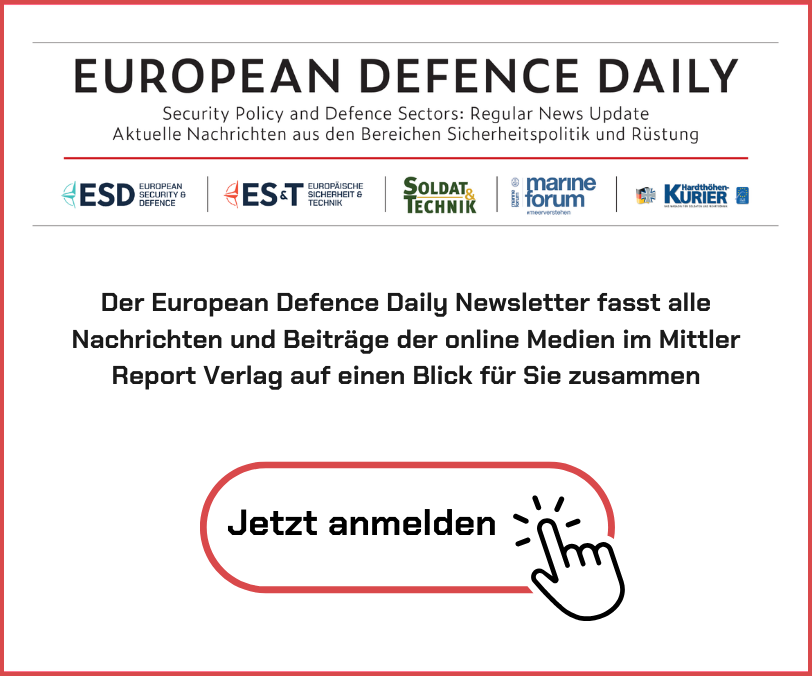How do you accumulate a small fortune? By starting with a big one. This old realisation means that you should be careful with a financial cornucopia. And the 2026 defence budget is such a cornucopia. To put it in context: the decision to suspend the constitutionally enshrined debt brake for defence and infrastructure will result in a defence budget of a completely new dimension: in 2026, a "base amount" of one percent of economic output will be allocated to defence in the federal budget, All further expenditure beyond this will not be counted towards the debt brake. According to calculations by budget experts, the €100 billion "Bundeswehr special fund" will expire in 2027. For the 2026 budget, which the Federal Cabinet adopted before the summer break and submitted to Parliament for approval, expenditure is planned in the regular section 14 (defence) and the remainder of the special fund. Both documents must be placed side by side.
The 2026 federal budget is the first draft budget to bear the original signature of the Christian Democrat-Social Democrat coalition. It reflects dramatic increases in the defence force. The explanatory notes to the "Government Draft Federal Budget 2026 and Federal Financial Plan 2025 to 2029" state: "The expenditure earmarked for the defence budget in the government draft for the 2026 budget will increase by around €29.4 billion to around €82.7 billion compared to the financial plan. Funds totalling €100 billion have been made available through the Bundeswehr special fund, of which around €25.5 billion is earmarked for 2026." In the current financial plan, defence spending is set to rise to €152.8 billion in 2029.
In Chapter 1405 (Military Procurement) Title 554 12 (Procurement of ships, operational watercraft, boats, floating and other naval equipment), commitment appropriations/VE (authorisation for long-term contractual commitments) of around € 36.6 billion are shown for 2026 until 2041 (2027: around € 1.9 billion). This does not affect individually budgeted projects (Epl. 14 and special assets) such as F 126, U 212CD or naval fuel suppliers. An F 127 project with an estimated VE of € 10 billion could easily be transferred to a new project title.
Truly a cornucopia that also invites inefficiency and waste. In this context, we remember an experienced budget expert in the parliamentary arena: don't look at the amount that is made available at the beginning of the year, but at what is not spent at the end of the year! The reasons for the lack of outflow of budget funds are complex: delivery bottlenecks, lack of orders and lack of personnel (contract lawyers, acceptance experts). We cannot recognise an ordering hand! The new, third, State Secretary in the BMVg comes from the Federal Chancellery under Olaf Scholz and is to be responsible for armaments, innovation and cyber. However, he still has to acquire the patent for "procurement projects on a long journey".
The Navy has mapped out a "Course 2025" and is facing up to the public debate. We are curious to see how the parliamentary committees for defence and budget will deal with the current irritating developments in the F 126 project and possible consequences for F 127, and what consequences they will demand. The topic needs a serious discourse; it must not be left to agitated members of the "commentariat" on social media.
However, this requires reliable information about current NATO demands (on Germany) - without ignoring the necessary degree of confidentiality within the Alliance. What does the Alliance expect from Germany? What specific contribution should the German Navy make? This is where "butter must be put on the fish"! At the moment, there is only - more or less reliable - conjecture. Such a mixed situation does not do justice to the challenges and the financial resources available. Siren calls to satisfy procurement demands politically cheaply and generously "across the board" can be heard. The warning should therefore be repeated here: ... and do not lead us into temptation!
Heinz Schulte is a member of the Executive Board of the German Maritime Institute.
Heinz Schulte











One Response
Heinz Schulte's article hits a sore point in German security policy: we are faced with a cornucopia of financial resources, but at the same time the temptation to waste this money through hesitation, bureaucratic inefficiency or strategic ambiguity. The central demand for a "serious discourse" is therefore more than just an appeal - it is a necessity. But what characterises such a discourse? It is not limited to the repetition of capability gaps or the call for more budget. A serious discourse is constructive; it brings concrete, well thought-out and, above all, feasible proposals to the table. It combines the strategically desirable with the technologically and temporally realisable.
This is precisely where the idea of not viewing the "Future Combat Surface System" (FCSS) as a monolithic large-scale project, but rather splitting it up intelligently and thus massively accelerating the introduction of unmanned systems, comes in. This should not be an abstract mind game, but a tangible proposal that brings the spirit of the often-mourned speedboats into the 21st century.
The anatomy of a realisable proposal
The proposed division of the FCSS programme into two parts is a prime example of proactive pragmatism:
The medium-weight platform - evolution instead of revolution: The Navy's decision to rely on market-available systems from the outset as part of the Operational Experimentation (OPEX) for the FCSS is the only correct and pragmatic approach. It underpins the "evolution instead of revolution" approach and avoids the typical risks of a completely new development from the outset, which experience has shown to be associated with incalculable delays, cost explosions and technical "teething troubles". A concept such as the Norwegian Skjold class serves as an excellent example of the philosophy behind such an approach: You use a seaworthy and fast platform that has been tried and tested by a NATO ally as a basis. This allows development resources to concentrate fully on the complex task of unmanned system integration. These unmanned units, weighing around 274 tonnes, would form the backbone of the distributed maritime strike force. An initial batch of 18 units, assigned to the K130 class corvettes, would exponentially increase their sensor range and effective radius. The corvette would be transformed from a lone operator into the commander of a deadly pack. A second batch could then be operationally assigned to the new 405 class tenders (MUsE) in a ratio of 1:6, thus reactivating the proven doctrine of the fast patrol boat squadrons in a modern, unmanned form.
The lightweight platform - pragmatically prioritising a planned capability: This is not a new requirement, but the consistent acceleration of an already recognised need. In the "Marine 2025 course", the introduction of unmanned multi-purpose combat boats (FCSS) is planned by 2035 anyway. The proposal to procure market-available, lighter unmanned platforms in parallel with the FCSS brings this essential capability forward by almost a decade. Systems such as the "CB90 NG with Autonomous Ocean Core" are adaptable and could close the capability gap, which is already evident today, in a timely manner. Twenty such drones could serve as the first wave in an approach to hold down the enemy and spare the lives of the marines. Their possible further tasks in the light escort of support units or object protection of naval bases and in "loss-tolerant" reconnaissance not only make sense, but also relieve the highly complex and our few frigates and corvettes of tasks for which they are overqualified.
This approach would not overturn the "Marine 2025 course" plan, but would pragmatically accelerate it and fill it with life.
Proactivity as an alliance contribution: the answer to temptation
This leads us to the crucial question raised by the article: wait for detailed demands from NATO or become proactive ourselves? The answer must be a clear plea in favour of the second option. In such a rapidly changing threat situation, waiting for a detailed catalogue of demands agreed by 32 members is a sure path to strategic passivity.
Proactivity here does not mean going down a special national path. On the contrary, it means offering the alliance what Germany can do quickly and effectively. It means approaching NATO and saying: "We have analysed the threat in the Baltic Sea and the North Atlantic. Based on the technology of our allies, we can build a powerful, scalable fleet of unmanned systems by early 2029 that will advance maritime surveillance and defence. Let's work together to define how best to integrate this capability into alliance defence."
This is the "butter to the fish" that Heinz Schulte is calling for. It is the constructive alternative to the temptation to either let the cornucopia of the defence budget seep away in prestigious large-scale projects or not to touch it at all out of sheer helplessness. This in no way means abandoning visionary projects. On the contrary: research and the start of projects for major long-term projects such as the F127 frigate or, in particular, the future Large Remote Missile Vessels (LRMV) must begin now, because these are marathons and not sprints like the FCSS outlined here. Serious discourse, coupled with the courage to find pragmatic and quick solutions, is the only way to turn money into capability and capability into a relevant contribution to our own security and that of our allies.
In the end, the only question that remains is whether this piece of writing is itself part of the required "serious discourse" - or ultimately just another voice from the "commentariat" that the author criticises.